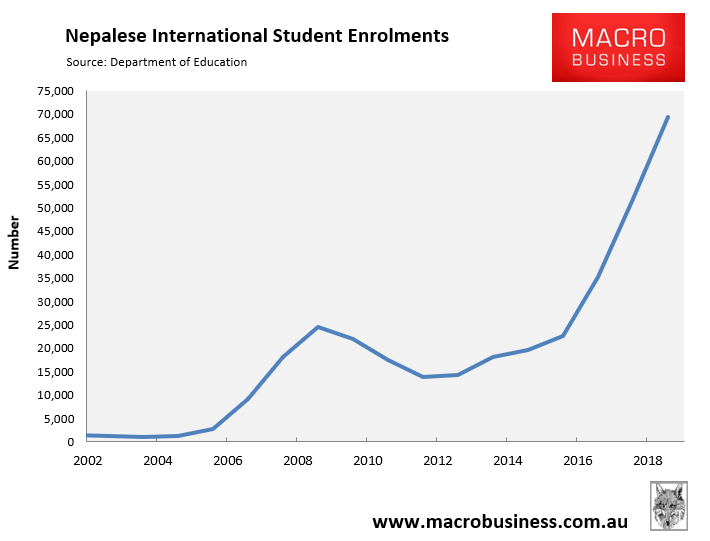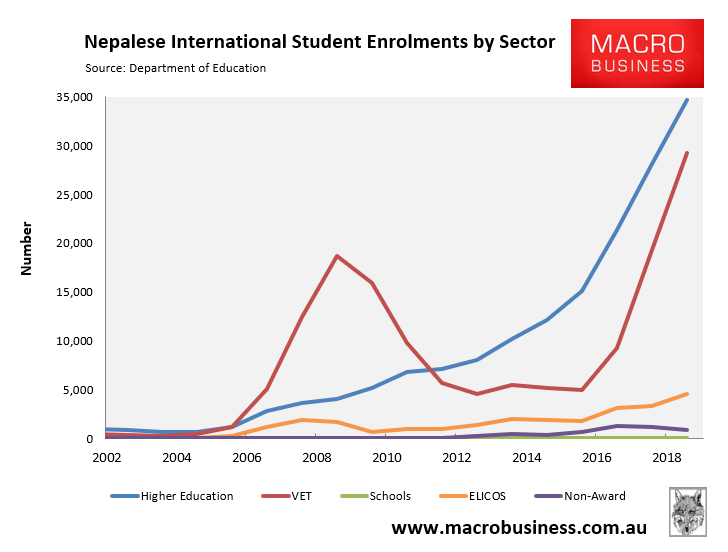Over the past three calendar years, Nepal became Australia’s fastest growing international student market, growing by more than 200% to around 70,000 in 2019:

Nepal also became Australia’s third biggest international student source country behind China (260,000) and India (144,000).
As shown in the next chart, the explosive growth in Nepalese international students was driven by the university (higher education) and Vocational Education and Training (VET) sectors, where enrolments ballooned by 130% and 490% respectively in the three years to 2019:

The surge in Nepalese international students has long been viewed as evidence that Australia’s education industry has badly eroded entry standards to accelerate student growth.
For example, education experts late last year warned that the explosion in Nepalese students had been driven by dodgy education agents offering promises of working rights and permanent residency:
The number of education agents – or recruiters – operating in Nepal has leapt from a few hundred to more than 3000…
The trend has alarmed higher education experts, who warn it is unlikely the students can genuinely afford to study in Australia, and are likely involved in exploitative work to pay for their tuition…
Andrew Norton, professor of higher education policy at the Australian National University, said the Nepalese influx should be “red-flagged” by the Department of Home Affairs…
Professor Norton said Nepalese international students had “an extremely high number” of secondary applicants on their visas, “suggesting to me that maybe they’re bringing in their spouses to work”…
Economist Tim Colebatch raised similar concerns:
Deregulation has allowed universities to selectively lower their standards to bring in more fee-paying foreign students, even when they fail to meet the thresholds for English language skills or academic achievement…
This is not the first time immigration from Nepal has surged. A decade ago, we saw a scam with training visas, in which “students” from India and Nepal came for training courses in Australia, then quickly vanished into the workforce. The scam saw net immigration set record levels in 2008–09, before then immigration minister Chris Evans shut it down. But most of those who came stayed on here.
With this background in mind, it is no surprise to read that Nepalese international students are struggling to pay their bills and are demanding taxpayer welfare:
Nepalese student Madan Subedi says he is “suffering unimaginably” as he tries to find money for tuition, groceries and utilities after he lost his job, but as an overseas student cannot claim JobSeeker assistance…
Mr Subedi is in his third year of an MBA in professional accounting at the private higher-education provider Holmes Institute…
He had been working as a chef in Melbourne for 20 hours a week but since losing his job has been short by $2000 a month…
On April 3, Prime Minister Scott Morrison said if international students were not in a position to support themselves “there is the alternative for them [but] to return to their home countries”…
“I am just disappointed because of the gesture he showed towards the different species called international students” [Mr Subedi said]…
The boom in Nepalese students is more bonafide proof that the entry requirements that international students must satisfy in order to be granted a visa have been set far too low.
English-language and financial requirements must be significantly lifted.
The primary motivation for international students to come to Australia must be to study, not as a means of gaining backdoor working rights and/or permanent residency.

